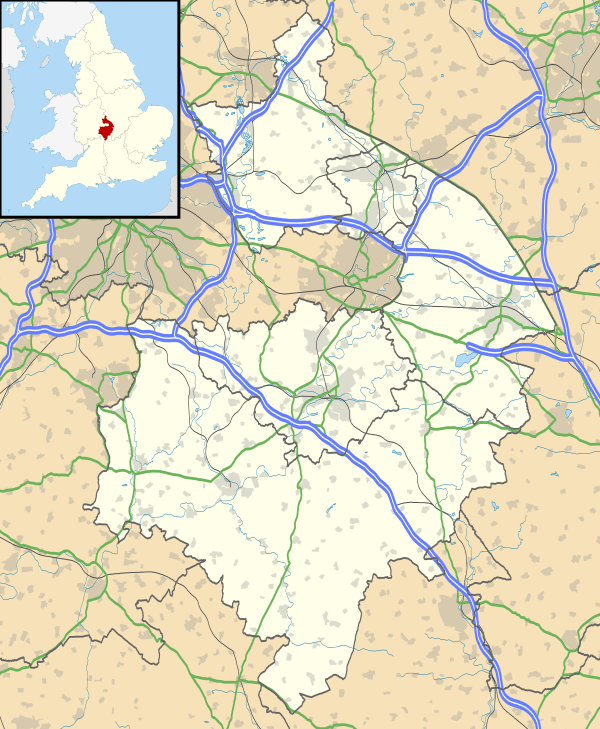Baginton
| Baginton | |
|---|---|
|
View along Coventry Road, Baginton showing buildings about 4 miles away in Coventry city centre in the distance. | |
 Baginton Baginton shown within Warwickshire | |
| Population | 755 (2011) |
| OS grid reference | SP3474 |
| Civil parish |
|
| District | |
| Shire county | |
| Region | |
| Country | England |
| Sovereign state | United Kingdom |
| Post town | COVENTRY |
| Postcode district | CV8 |
| Dialling code | 024 |
| EU Parliament | West Midlands |
| UK Parliament | |
Baginton is a village and civil parish in the Warwick district of Warwickshire, England, and has a common border with the City of Coventry of the West Midlands county.[1] With a population of 801 (2001 Census), Baginton village is four miles (6.5 km) south of Coventry city centre and seven miles (11 km) north of Leamington Spa. The population had reduced slightly to 755 at the 2011 Census.[2] The Lucy Price playing field is situated centrally in the village.
Geography and administration
Coventry Airport (built 1936), the Lunt Roman Fort and the ancient "Baginton oak" tree are within the village, whilst the Midland Air Museum and Electric Railway Museum, Warwickshire are just outside Baginton.
The road from Baginton to southern Coventry (the city's Finham district) passes over the River Sowe near an old mill, which now is inhabited by a restaurant and hotel called The Old Mill.
Baginton is often misspelt / mispronounced as 'Bagington'.
History
The Domesday Book records that in the 11th century Baginton consisted of 15 households and a mill.
Coventry Airport
Baginton is home to Coventry Airport, which lies just southeast of the village. First opened in 1936 as Baginton Aerodrome, it has been used for general aviation, flight training, and commercial freight and passenger flights. It had a grass surface for aeroplanes to land and take off.[3] With World War II it became a fighter airfield. By October 1941 308 Polish squadron were located at Baginton.[4]
The Midland Air Museum on Rowley Road is adjacent to the northern boundary of Coventry Airport.
Landmarks
Lunt Fort
The remains of the ancient Roman Lunt Fort have been found in Baginton on the north side of the village. Parts of the fort were reconstructed in the 1970s, and it has become a popular site for school visits, as well as holding activity days during the summer.
Church of St John the Baptist
The Church of St John the Baptist is situated in the old part of Baginton. A scenic footpath starts near the church and leads to Stoneleigh.
Baginton Castle and Fish Ponds
Henry Percy, 1st Earl of Northumberland was imprisoned at Baginton Castle following his son Harry Hotspur's defeat at the Battle of Shrewsbury.[5] The ruin that can be seen is of a late fourteenth-century house, but it is not well known due to its location in an area of woodland on private land. If Baginton Castle did exist here before this house, there is no sign of its ruins. The area was fenced off in 2006, and now the ruins and former fishponds can be viewed by arrangement with the local farmer who owns the land.
Baginton Castle and Fish Ponds constitute a Scheduled Monument.[6] The vestiges of the castle are a Grade II listed building.[7]
Baginton oak tree
Baginton is the site of an old oak tree which is often called the Baginton oak. It is about 300–350 years old and is thought to be one of the oldest trees in Warwickshire. A nearby public house is called The Oak.
Gallery
- The Baginton oak in summer
- The Baginton oak in summer
- The Lucy Price playing field
- Coventry Airport gates, Baginton
- St John the Baptist Church, Baginton
- Reconstructed main gate (inner aspect) of Lunt Fort
References
- ↑ AA Street by Street. Coventry Rugby (2nd edition (May 2003) ed.). AA Publishing. pp. 53–4. ISBN 0-7495-3973-9.
- ↑ "Civil Parish population 2011". Retrieved 23 December 2015.
- ↑ Evans, Ann. Remember when: Sheep grazed quietly in Baginton's lanes Coventry Telegraph 13 January 2004
- ↑ James Hutchison, ‘Thomas, Forest Frederic Edward Yeo-(1902–1964)’, rev. Oxford Dictionary of National Biography, Oxford University Press, 2004; online edn, Jan 2010
- ↑ Bean, J. M. W. (2004). "Percy, Henry, first earl of Northumberland (1341–1408)". Oxford Dictionary of National Biography. Oxford University Press.
- ↑ Historic England. "Baginton Castle, associated settlement remains, ponds and mill sites (1011193)". National Heritage List for England. Retrieved 21 January 2018.
- ↑ Historic England. "Ruins of Castle 160 yards west of Church of St John (Grade II) (1035269)". National Heritage List for England. Retrieved 21 January 2018.
- Domesday Book
- Dugdale, Sir W. 1730 The Antiquities of Warwickshire, 2nd Ed. (ed. W. Thomas), London
- Edwards, J.H. 1953 'Baginton Castle Excavations', Trans. Birm. Warwicks. Arch. Soc., 69 (1951), 44–49.
- Smith, W. 1829 A New and Complete History of the County of Warwick, Birmingham
External links
| Wikimedia Commons has media related to Baginton. |
